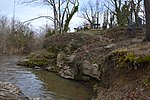Ampthill (Chesterfield County, Virginia)
Cary family of VirginiaCentral Virginia geography stubsGeorgian architecture in VirginiaHouses in Chesterfield County, VirginiaJames River plantations ... and 1 more
Pre-statehood history of Virginia

Ampthill Plantation was located in the Virginia Colony in Chesterfield County on the south bank of the James River about four miles south of the head of navigation at modern-day Richmond, Virginia. Built by Henry Cary, Jr. about 1730, it was just upstream of Falling Creek. It was later owned by Colonel Archibald Cary, who maintained a flour mill complex and iron forge at the nearby town of Warwick. Mary Randolph was born there in 1762.
Excerpt from the Wikipedia article Ampthill (Chesterfield County, Virginia) (License: CC BY-SA 3.0, Authors, Images).Ampthill (Chesterfield County, Virginia)
Geographical coordinates (GPS) Address Nearby Places Show on map
Geographical coordinates (GPS)
| Latitude | Longitude |
|---|---|
| N 37.450527777778 ° | E -77.440972222222 ° |
Address
23234
Virginia, United States
Open on Google Maps







